Scabs on Scalp: A Complete Overview
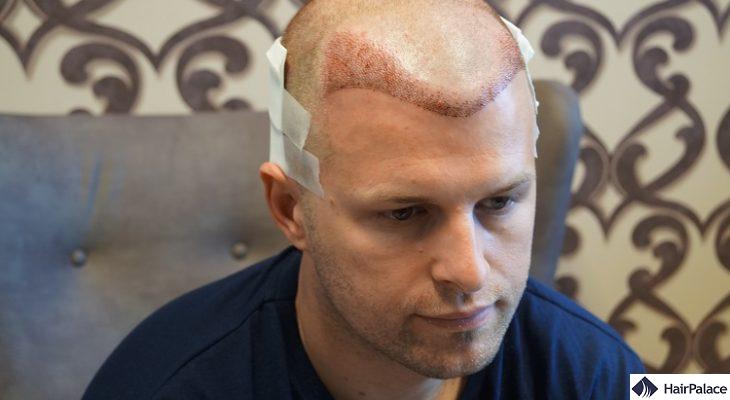
Scabs on scalp can be uncomfortable, unsightly, and sometimes even worrying.
While they’re often harmless and temporary, they can also signal underlying issues such as skin irritation, infections, or chronic conditions.
Understanding the potential causes, symptoms, and treatment options is crucial for finding relief and restoring scalp health.
In this article, we’ll explore why scabs form on the scalp, how to recognise different types, and what you can do to treat and prevent them effectively.
- What causes scabs on scalp?
- Types of scabs on the scalp
- Diagnosis and when to see a doctor
- Treatment for scabs on scalp
- Special scabs in hair
- Prevention tips for a healthy scalp
What causes scabs on scalp?
Even simple habits like frequent picking, scratching, or trauma to the scalp can create open sores that crust over during healing.
In some cases, dry scabs on scalp are linked to underlying autoimmune or chronic skin disorders, making it important to identify the root cause to choose the right treatment.
Let’s take a look at some of the most common causes of scalp sores in detail.
Seborrheic dermatitis and dandruff
Seborrheic dermatitis commonly appears on areas with many oil glands, such as the scalp, and is frequently linked to dandruff.
It causes redness, irritation, and greasy patches covered with white or yellow scabs on scalp.
Dandruff is considered a milder form of seborrheic dermatitis and typically presents as loose, white flakes without significant inflammation.
While the exact cause isn’t fully understood, several factors may contribute, including excess oil production, an overgrowth of fungus, stress, weather changes, and genetic predisposition.
These elements can disrupt the scalp’s natural balance and trigger inflammation.
Although seborrheic dermatitis and dandruff are not contagious or dangerous, they can be persistent and uncomfortable.
Psoriasis on the scalp
Psoriasis on the scalp is a chronic skin condition that leads to the formation of thick, itchy scabs on scalp.
These patches are often covered with silvery-white scales and can appear along the hairline, behind the ears, or on the back of the neck.
The affected areas may feel sore or tight, and in some cases, scratching can lead to bleeding or temporary hair loss.
Although the exact cause is not fully understood, it involves an overactive immune response that speeds up skin cell production.
While scalp psoriasis is not contagious, it tends to flare up in cycles and can be managed with medicated shampoos, topical treatments, and lifestyle adjustments.
Contact dermatitis and irritation
Contact dermatitis and irritation occur when the skin reacts to a substance that causes inflammation or damage.
There are two main types of contact dermatitis.
Irritant contact dermatitis occurs when harsh chemicals or friction damage the skin’s outer layer.
Allergic contact dermatitis, on the other hand, develops when the immune system overreacts to an allergen such as fragrances, metals, or certain hair products.
Symptoms typically include redness, itching, burning, dryness, and sometimes blisters or flaking.
These reactions can cause tenderness, soreness, as well as hair loss and scabs on scalp.
Folliculitis (Inflamed hair follicles)
Folliculitis is the inflammation of hair follicles, usually caused by bacterial or fungal infection, skin reaction, or blockage.
It appears as red scabs on scalp, but it can also seem like white bumps that may look like acne and can be itchy, painful, or filled with pus.
On the scalp, folliculitis often develops from friction, sweating, excess oil, or the use of occlusive hair products that trap bacteria.
Fungal infections (Tinea capitis)
Fungal infections of the scalp, known as tinea capitis or scalp ringworm, are caused by dermatophyte fungi that invade the hair shafts and follicles.
This condition is contagious and most common among children, though adults can be affected as well.
Symptoms typically include scaly, itchy patches on the scalp, hair breakage, and sometimes areas of hair loss or swelling with pus-filled lesions.
The infection spreads through direct contact with an infected person or by sharing contaminated items such as combs, hats, or bedding, and it can even be transmitted by pets.
Scabs from picking or trauma
Scabs from picking or trauma form when the scalp is injured by scratching, picking at existing bumps, or friction from tight hairstyles or headwear.
These small wounds trigger the body’s natural healing response, leading to the formation of scabs as the skin repairs itself.
However, repeatedly picking at the area can slow healing and increase the risk of infection.
It may also cause scarring or damage to hair follicles, leading to temporary or even permanent hair loss.
Rare autoimmune or chronic skin conditions
Rare autoimmune or chronic skin conditions affecting the scalp include disorders such as lupus erythematosus, lichen planopilaris, and dermatomyositis.
All of these conditions can cause inflammation, scaling, and hair loss.
In these conditions, the immune system mistakenly attacks healthy skin and hair follicles, leading to scarring or permanent alopecia if left untreated.
Symptoms may include redness, thickened or discoloured patches, tenderness, or a burning sensation on the scalp.
Types of scabs on the scalp
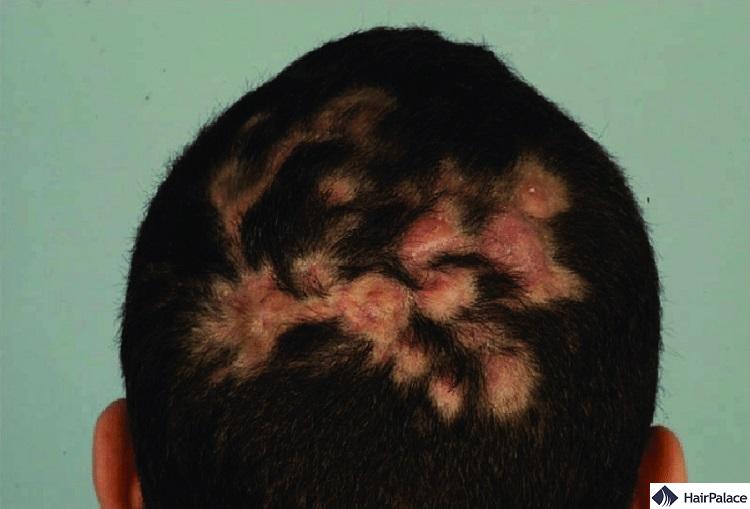
Different types of scalp scabs can appear depending on their cause, colour, or texture. Below are some of the most common forms and their potential indications.
Seborrheic dermatitis and dandruff
Scabs linked to seborrheic dermatitis and dandruff often appear greasy, flaky, or yellowish, forming on areas where the scalp produces more oil.
They can range from thin, soft flakes to thicker, crusty patches that adhere to the skin.
The texture is usually oily to the touch, and the affected areas may look slightly red or inflamed.
Unlike dry scabs on scalp, these tend to recur in cycles, especially during stress or colder weather, and are often accompanied by itching or mild irritation rather than pain.
Psoriasis on the scalp
Psoriasis on the scalp is a chronic skin condition that causes thick, scaly patches to form on the scalp.
These patches are often covered with silvery-white scales and can appear along the hairline, behind the ears, or on the back of the neck.
The affected areas may feel itchy, sore, or tight, and in some cases, scratching can lead to bleeding or temporary hair loss.
Although the exact cause is not fully understood, it involves an overactive immune response that speeds up skin cell production.
While scalp psoriasis is not contagious, it tends to flare up in cycles and can be managed with medicated shampoos, topical treatments, and lifestyle adjustments.
Contact dermatitis and irritation
Contact dermatitis and irritation occur when the skin reacts to a substance that causes inflammation or damage.
There are two main types of contact dermatitis.
Irritant contact dermatitis occurs when harsh chemicals or friction damage the skin’s outer layer.
Allergic contact dermatitis, on the other hand, develops when the immune system overreacts to an allergen such as fragrances, metals, or certain hair products.
Symptoms typically include redness, itching, burning, dryness, and sometimes blisters or flaking.
On the scalp, these reactions can cause tenderness, soreness, as well as hair loss and scabs on scalp.
Folliculitis (Inflamed hair follicles)
Folliculitis is the inflammation of hair follicles, usually caused by bacterial or fungal infection, irritation, or blockage.
It appears as small white or red scabs on the scalp that may resemble acne.
These scabs can be itchy, painful, or filled with pus.
On the scalp, folliculitis often develops due to friction, sweating, or excess oil.
The use of occlusive hair products that trap bacteria can also contribute to the condition.
Fungal infections (Tinea capitis)

Fungal infections of the scalp, known as tinea capitis or scalp ringworm, are caused by dermatophyte fungi that invade the hair shafts and follicles.
This condition is contagious and most common among children, though adults can be affected as well.
Symptoms typically include scaly, itchy patches on the scalp, hair breakage, and sometimes areas of hair loss or swelling with pus-filled lesions.
Scabs from picking or trauma
Scabs from picking or trauma form when the scalp is injured by scratching, picking at existing bumps, or friction from tight hairstyles or headwear.
These small wounds trigger the body’s natural healing response, leading to the formation of scabs as the skin repairs itself.
However, repeatedly picking at the area can delay healing, cause infection, and even lead to scarring or hair follicle damage that may result in temporary or permanent hair loss.
Yellow scabs on scalp
Yellow scabs on the scalp often indicate the presence of infection, excessive oil buildup, or a skin condition such as seborrheic dermatitis or impetigo.
These may appear as greasy or crusty scabs on scalp, and sometimes ooze fluid before drying into a yellowish crust.
In seborrheic dermatitis, the yellow scabs are typically accompanied by itching, redness, and flaky dandruff, while in impetigo, they may result from bacterial infection and spread quickly.
Constant scratching or picking can also worsen the condition and delay healing.
White scabs on scalp
White scabs on the scalp are often caused by dryness, flaking skin, or conditions such as seborrheic dermatitis, psoriasis, or contact dermatitis.
They usually appear as dry, crusty patches or flakes that may itch or feel tight.
In some cases, excessive scratching or picking at these areas can cause minor wounds that crust over as they heal, forming small white scabs.
Product buildup or sensitivity to hair care ingredients can also contribute to irritation and scaling.
Red or bloody scabs on scalp
Red or bloody scabs on scalp usually develop when the skin is damaged or inflamed, often from scratching, picking, or underlying conditions like psoriasis, eczema, or folliculitis.
The redness indicates irritation or active inflammation, while the presence of blood suggests that the skin barrier has been broken.
These scabs can become painful or infected if they are repeatedly disturbed or if bacteria enter the open wounds.
Crusty scabs on scalp
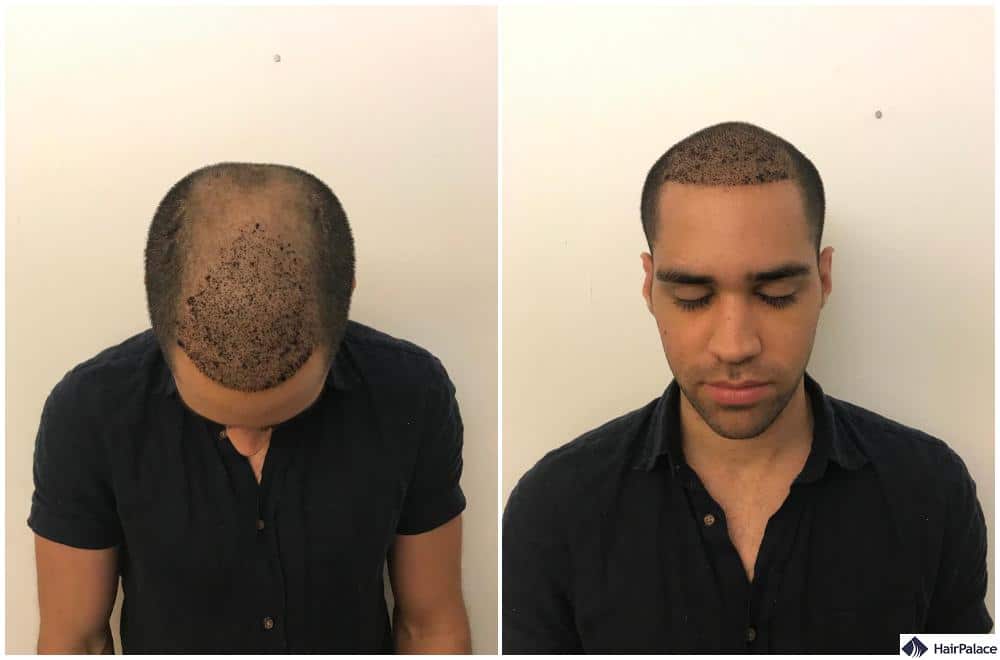
Crusty scabs on the scalp often form when the skin becomes inflamed, irritated, or infected, leading to the buildup of dried fluid, oil, or dead skin.
They can develop from conditions like seborrheic dermatitis, psoriasis, eczema, or bacterial infections, as well as from repeated scratching or picking.
These scabs may feel rough or thick to the touch and are sometimes accompanied by itching, redness, or soreness.
It’s important not to pick at the scabs, as doing so can delay healing, cause infection, or lead to scarring and temporary hair loss.
Itchy scabs on scalp
Itchy scabs on the scalp are a common sign of irritation, inflammation, or underlying skin conditions such as seborrheic dermatitis, psoriasis, eczema, or allergic reactions.
The itching often leads to scratching, which can worsen the irritation, damage the skin barrier, and result in scab formation.
In some cases, fungal or bacterial infections can also trigger itching and crusty patches.
Small scabs on scalp
Small scabs on the scalp often result from minor irritation, scratching, or blocked hair follicles.
They can appear as tiny crusted spots or bumps that may be itchy or tender to touch.
Common causes include mild folliculitis, allergic reactions to hair care products, dandruff-related inflammation, or habitual picking.
In most cases, these scabs heal on their own if the scalp is kept clean and free from further irritation.
Avoiding harsh shampoos, scratching, or tight hairstyles can help prevent scabs in hair and hair loss.
Diagnosis and when to see a doctor
Diagnosing the cause of scalp scabs typically involves a physical examination by a dermatologist, who may look at the pattern, colour, and texture of the lesions.
In some cases, additional tests such as skin scrapings, cultures, or biopsies may be done to determine if an infection, autoimmune disorder, or chronic skin condition is responsible.
While mild scabs caused by irritation or dryness often heal with proper scalp care, you should see a doctor if the scabs are painful, spreading, oozing, or not healing within a couple of weeks.
Persistent itching, hair loss, or thick crusting also warrant medical attention.
These may signal underlying conditions like psoriasis, fungal infections, or other inflammatory scalp disorders that require prescription treatment.
Treatment for scabs on scalp
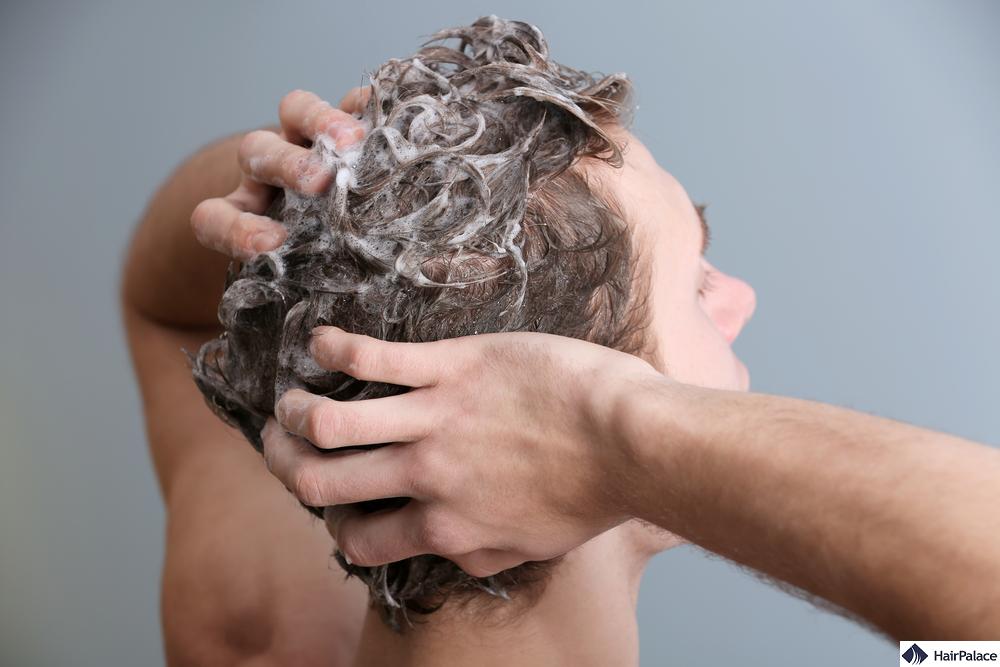
While itchy scabs on scalp can be an uncomfortable thing to deal with, there are many options to ease the condition and restore your scalp to a healthy state.
General care and hygiene to prevent small scabs on scalp
Treatment for scabs on the scalp depends on the underlying cause but generally focuses on reducing inflammation, soothing irritation, and preventing infection.
Mild cases caused by dryness or minor irritation can often be managed with gentle, fragrance-free shampoos and moisturizers to keep the scalp hydrated.
Avoiding scratching, harsh chemicals, and tight hairstyles is essential to prevent worsening or reinjury.
Medicated shampoos and topical treatments
Medicated shampoos and topical treatments are key components in managing scabs on the scalp, especially when caused by dandruff, psoriasis, or infections.
Antifungal shampoos containing ketoconazole, selenium sulfide, or zinc pyrithione help control yeast overgrowth and reduce itching and flaking.
For conditions like psoriasis or seborrheic dermatitis, shampoos with salicylic acid, coal tar, or ciclopirox can soften thick scales and calm inflammation.
Topical corticosteroids, available as lotions, foams, or ointments, help relieve redness and itching by reducing immune-related inflammation.
In some cases, antibacterial or antibiotic creams may be prescribed if an infection is present.
Moisturising scalp oils with ingredients like aloe vera or coconut oil can support healing and prevent dryness.
At home scabs on scalp treatment
At-home treatments for scabs on the scalp focus on gentle care, cleanliness, and soothing the skin to promote healing.
Start by washing your hair with a mild, sulfate-free shampoo to remove dirt and excess oil without irritating the scalp.
Avoid scratching or picking at the scabs, as this can delay healing and cause infection.
Applying warm compresses for a few minutes can help soften crusts and relieve itching.
Natural remedies like aloe vera gel, coconut oil, or tea tree oil (diluted) may help soothe inflammation and reduce microbial growth.
Keeping the scalp moisturized and avoiding tight hairstyles or harsh hair products are also important.
Professional scalp scabs treatment
For chronic conditions such as psoriasis, seborrheic dermatitis, or lichen planopilaris, targeted therapies may be required.
These can include immunosuppressive drugs, vitamin D analogs, or light therapy (phototherapy) to control inflammation and prevent scarring.
In cases of secondary infection, antibacterial or antifungal therapy is essential to stop the spread.
Professional scalp treatments at dermatology clinics, such as scalp exfoliation, gentle cleansing, or laser therapy, can also help remove buildup, improve circulation, and support healing.
Regular follow-ups ensure that the treatment plan remains effective and prevents recurrence.
Special scabs in hair
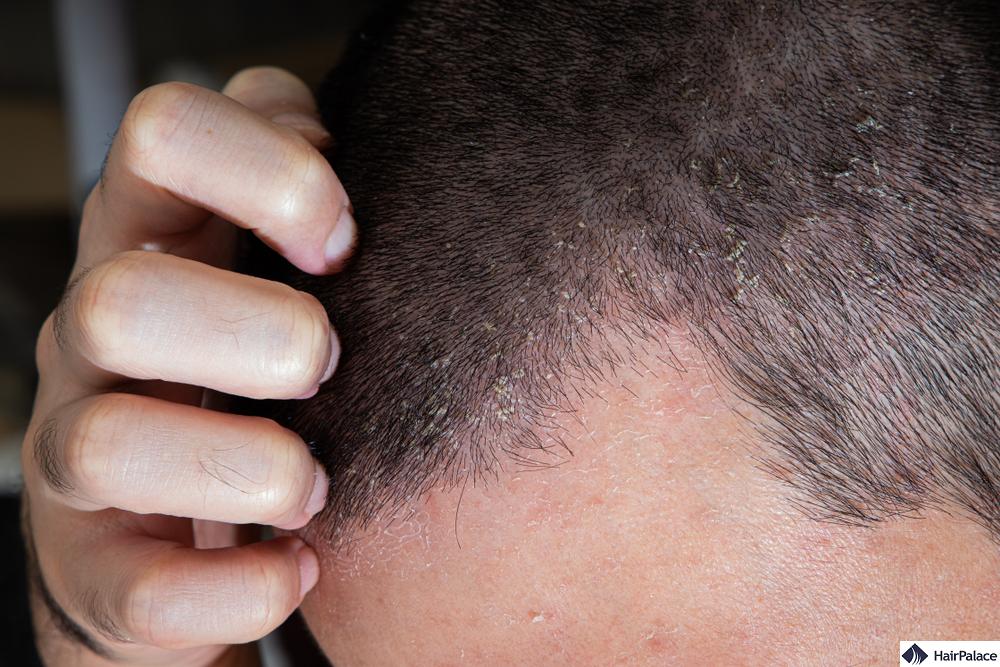
Special scabs in the hair are persistent, thick, or unusual crusts that form on the scalp.
They often develop due to underlying skin disorders, infections, or autoimmune conditions.
Unlike small or temporary scabs from minor irritation, these are dense, adherent, and tend to recur.
In some cases, they can cover large areas of the scalp.
Conditions such as psoriasis, seborrheic dermatitis, tinea capitis, or impetigo may cause these lesions. They often lead to itching, pain, and even temporary hair loss.
In severe cases (such as pityriasis amiantacea) the scabs form thick, waxy layers that cling to hair shafts.
Treatment may involve prescription medicated shampoos, topical corticosteroids, antifungal or antibiotic therapy.
Hair transplant donor area scabs
Scabs in the hair transplant donor area are a normal part of the healing process following surgery.
They typically form within the first few days after graft extraction as the tiny wounds from the follicle removal begin to close.
These scabs protect the area from infection and usually start to flake off naturally within 7–10 days.
It’s important not to scratch or pick at them, as this can damage the healing tissue, cause bleeding, or lead to scarring.
Gentle washing with a saline solution or mild shampoo, as instructed by the clinic, helps soften and remove the scabs safely.
If the donor area remains red or painful, it may indicate irritation or delayed healing.
Signs of infection, such as swelling, pus, or persistent scabbing beyond two weeks, should not be ignored.
In these cases, it’s recommended to contact the surgeon for follow-up care.
Proper post-operative hygiene and moisturising sprays can also speed up recovery and improve the overall healing outcome.
Ingrown hair scabs scalp
Ingrown hair scabs on the scalp form when a hair curls back or grows sideways into the skin instead of emerging from the follicle.
This can cause localized inflammation, redness, and small scabs as the body reacts to the trapped hair.
They often resemble pimples or small bumps and may feel sore or itchy.
Common triggers include close shaving, friction from hats or helmets, and product buildup that clogs follicles.
To treat them, avoid scratching or picking, as this can worsen irritation or lead to infection.
Applying a warm compress can help open pores and release the trapped hair, while gentle exfoliation removes dead skin that may be blocking follicle openings.
For persistent or infected ingrown hairs, topical antiseptics or exfoliating acids like salicylic acid may be necessary.
In more severe cases, a dermatologist may prescribe antibiotic creams to promote healing and prevent recurrence.
Scabs in hair on head
Scabs in the hair on the head can develop from a range of causes, including dryness, infections, inflammation, or repeated scratching and picking.
They may appear as small crusty patches, thick plaques, or flaky spots attached to the scalp and hair strands.
In some cases, scabs form after mechanical irritation, such as tight hairstyles, harsh hair products, or scratching itchy areas.
Mild cases often heal with gentle cleansing, avoiding triggers, and using soothing or medicated shampoos.
Prevention tips for a healthy scalp
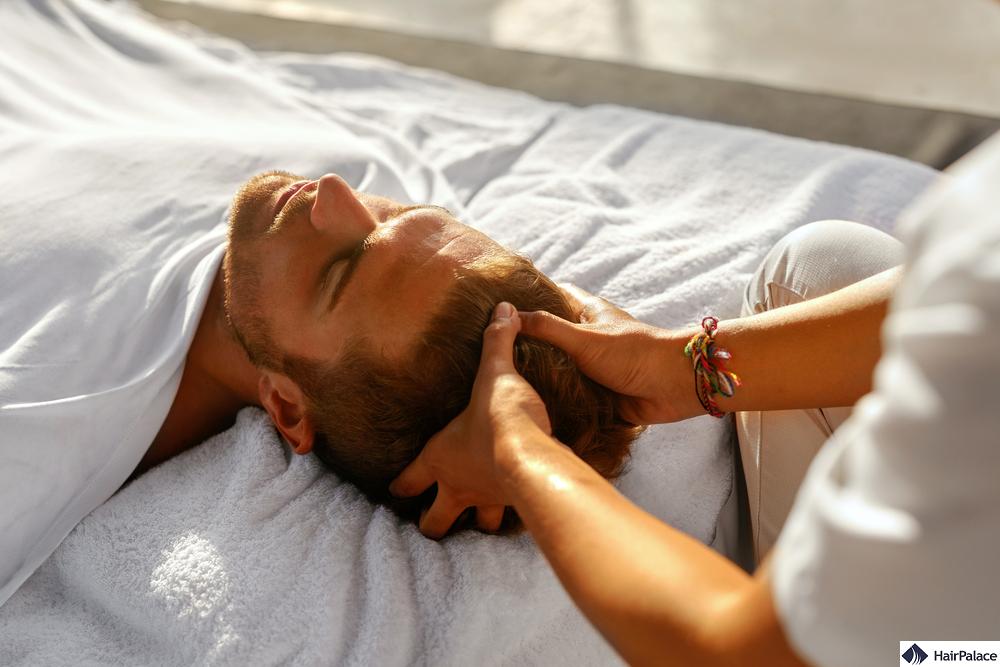
To prevent scabs on your scalp or irritation, practice consistent but gentle care.
Wash your hair regularly with a mild, sulfate-free shampoo to remove oil, dirt, and buildup without stripping natural moisture.
Avoid scratching, picking, or using harsh hair treatments like strong dyes or alcohol-based sprays that can damage the scalp barrier.
Keep your scalp hydrated with light conditioners or oils such as jojoba or batana oil, especially if you have dry skin.
Limit the use of tight hairstyles or headwear that cause friction and irritation.
Maintaining a balanced diet rich in vitamins, minerals, and hydration supports scalp and hair health from within.
Finally, manage stress and protect your scalp from too much sun. Both can trigger flare-ups of conditions like psoriasis or seborrheic dermatitis.
FAQ
To heal scabs on the scalp, avoid scratching or picking and keep the area clean with a gentle, sulfate-free shampoo. Applying soothing products like aloe vera or diluted tea tree oil can help reduce irritation. If scabs persist, become painful, or show signs of infection, consult a dermatologist for proper treatment.
Crusty scabs on the scalp often develop due to skin conditions like seborrheic dermatitis, psoriasis, or eczema. They can also appear from infections, allergic reactions, or excessive scratching that irritates the scalp.
To remove scalp scabs safely, use a gentle, medicated shampoo containing ingredients such as salicylic acid, ketoconazole, or coal tar. Avoid picking or scratching, and keep your scalp clean and moisturised to promote healing.
If you’ve been picking at your scalp, gently cleanse the area with a mild shampoo and avoid further irritation. Applying aloe vera gel, tea tree oil–infused products, or a soothing scalp serum can support healing and prevent infection.
- Montes Martínez I, Domínguez de Luis F, Agulla Budiño A. Costras en cuero cabelludo [Scabs on the scalp]. An Esp Pediatr. 1997 Sep;47(3):331-2. Spanish. PMID: 9499293.https://pubmed.ncbi.nlm.nih.gov/9499293/
- Schweiger D, Schoelermann AM, Filbry A, Hamann T, Moser C, Rippke F. Highly efficient and compatible shampoo for use after hair transplant. Clin Cosmet Investig Dermatol. 2015 Jul 22;8:355-60. doi: 10.2147/CCID.S86015. PMID: 26229498; PMCID: PMC4517519.https://pubmed.ncbi.nlm.nih.gov/26229498/
- Nadimi S. Complications with Hair Transplantation. Facial Plast Surg Clin North Am. 2020 May;28(2):225-235. doi: 10.1016/j.fsc.2020.01.003. PMID: 32312509.https://pubmed.ncbi.nlm.nih.gov/32312509/
- Moeckel C, Chacharidakis G, Balasis S, Queen D, Avram MR, Panagiotopoulou G. From Scalp Flaps to Follicular Units: A Historical Perspective on Hair Transplantation Techniques. Dermatol Surg. 2025 Nov 1;51(11):1011-1016. doi: 10.1097/DSS.0000000000004581. Epub 2025 Feb 26. PMID: 40008796.https://pubmed.ncbi.nlm.nih.gov/40008796/
- Uyama M. Recent Progress in Hair Science and Trichology. J Oleo Sci. 2024;73(6):825-837. doi: 10.5650/jos.ess23203. PMID: 38825536.https://pubmed.ncbi.nlm.nih.gov/38825536/


